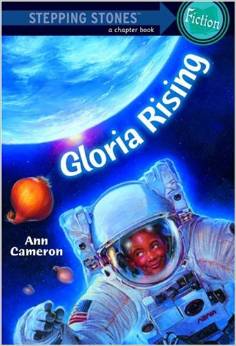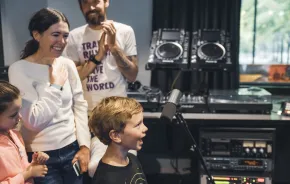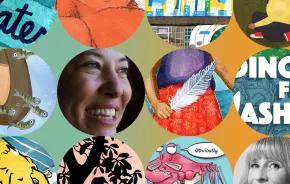
 When Felicia Oh and I managed Hullabaloo Books in West Seattle, we took great pleasure in running activity-based book clubs for kids. They were so successful that at one point we managed seven per month. When Hullabaloo closed in 2005, I migrated the book club model to my son’s school, where, led by parents, it thrived for several years.
When Felicia Oh and I managed Hullabaloo Books in West Seattle, we took great pleasure in running activity-based book clubs for kids. They were so successful that at one point we managed seven per month. When Hullabaloo closed in 2005, I migrated the book club model to my son’s school, where, led by parents, it thrived for several years.
Why an activity-based book club? While every kid loves a good story, not all love to read. An activity-based book club focuses not on reading skills, but on celebrating the story — characters, setting, themes and more — and taps into kids’ natural instinct to share ideas with peers, and to play and create. And for many reluctant readers, turning a book into a craft or activity with their friends is just the thing they need to get them over the hump.
[Read on for how to create an activity-based book club or jump to five winning books for a kids' book club.]
Key ingredients of an activity-based book club
Age: Any grade level work and you can start as early as first grade. By middle school, they’re moving on to other things, but until then ... it’s never too late to start!
Size and gender mix: 10–16 kids is good. Mixing boys and girls is not only possible, but ideal.
Book choice: Reading level is important, but keep in mind, some will read every book themselves, others will listen to audio, or do read-aloud, so you have wiggle room. Intentionally choose books with varying types of protagonists (boys, girls, animals, real, fiction, culturally diverse, historical, futuristic, funny, poignant, etc.). Throw in the occasional classic. Get input from parents and kids about books they’d like to include. Ask your school librarian for suggestions, or your local bookseller.
Where to meet: Options abound. Bookstores are often interested in hosting book clubs, and will give discounts for book-club purchases. Libraries and schools have rooms you can reserve in advance (some even allow snacks!). Rotating homes can be fun, and from time to time, you can have an outing. We usually had a summer picnic, as our last meeting of the school year.
Parents: While it only takes one or two to organize, the more adults who volunteer, the better. Parents can help with all kinds of tasks, from creating and managing craft boxes to organizing and bringing the "mystery snack."
Time frame: One-and-a-half hours (with cleanup) is about all you need
Sample itinerary for an activity-based book club
The basic model for this type of book club is: create, relate, think, talk, snack. Consistency matters. A plan, even if it's occasionally abandoned, helps you get organized and creates a continuity that kids appreciate. Here is our format for a memorable 90-minute event.
Craft or activities (15 minutes)
Have craft or activity materials related to the book ready to go when the first kids arrive – preferably with a sample (partial or complete) of what they’ll create. You should have a "craft box" with the basics – three or four sets of scissors, glues, crayons, markers, and then add what you need for a specific activity.
See our list on the next page for activity ideas, but you can get as simple or creative as you like. One of our favorites was veggie-head monsters, which we made as an activity after reading Zorgamazoo, a strange fantasy book in verse by Robert Paul Weston.
Have a back-up, mini-activity for kids who might finish early (or those who arrive early!, such as a word search or a coloring page with a character from the book.
During the activity, get kids on the floor, and get down there with them. And take it to the streets occasionally; the activity can be visiting an area celebrated in the book.
Book discussion (20 minutes)
After allowing five minutes for a transition from the activity (be patient) start a short, sweet discussion about the book. You can choose one or two of the five "elements of a story" to informally focus on: character, plot, conflict, setting, themes. You can mix it up: Talk about vocabulary, wordplay, point of view.
Introduce new literary concepts as you go – but remember, it’s not school! The intention is not to teach literature or terminology or concepts, so much as to support enthusiasm for reading and to demonstrate the power of story in community.
Find fun ways to get all participants discussing. For My Father’s Dragon, we packed a backpack with various items from the book (a comb, a stuffed dragon, tangerine, bubble gum, rope) and each kid picked one. That was their item to talk about from the story.
 Another strategy is to find a guest speaker with experience relevant to the book. When we read Endless Steppe, by Esther Hautzig, a grandfather of one participant spoke to the kids about his Jewish family’s experiences after WW II.
Another strategy is to find a guest speaker with experience relevant to the book. When we read Endless Steppe, by Esther Hautzig, a grandfather of one participant spoke to the kids about his Jewish family’s experiences after WW II.
The Internet is a wonderful resource for questions or activities. Check the publisher’s site first.
Discussion wrap-up (15 minutes)
You can do several things with wrap-up time.
Sharing time: Let kids introduce their creations to the group. (They loved sharing the veggie-headed monsters.!)
Expand knowledge: You can read from related picture books or reference books or even show a short video. For example, for The Mixed Up Files of Basil E. Frankweiler, by E.L. Konigsburg, you might use Where in the World? Around the Globe in Thirteen Works of Art.
Introduce next month’s read and solicit "pick" ideas. While I generally know the line-up for the next several books, I also like to get input from the kids. Kids loved introducing me to a book I didn’t know and having a favorite of theirs in the club!
Mystery snack and clean-up (20 minutes)
This is a critical, and very fun, element. The snack has to be a secret (and they will try to find out, so be strong), and it has to be from the book: Think Turkish delight for the Narnia books or Swedish crackers and loganberries for Pippi Longstocking.
If you want to occasionally skip the mystery element, you can also make the snack as part of your activity. For Double Fudge, by Judy Blume, we made chocolate caramel turtles.
Hopefully, helping parents will have assisted along the way, but kids should be expected to chip in with clean up.
Next: Five winning book titles for an activity-based book club.
Five winning books for an activity-based book club
 Geronimo Stilton series, by Geronimo Stilton (Scholastic, grades 1-3)
Geronimo Stilton series, by Geronimo Stilton (Scholastic, grades 1-3)
Summary: Geronimo the Italian journalist rodent has penned dozens of highly illustrated early-reader chapter books; in each, which he reluctantly overcomes a challenged adventure, while his sister, Thea, breezes through hardships, unfazed.
Craft and/or activity: Kid can work in threes to pursue a scavenger hunt around the school, house or library, with one clue leading to another. Each found item can reveal a mystery letter. The kids unscramble all of the mystery letters and work as one team to find the whereabouts of the final item – cheesecake!
Themes for discussion: Character descriptions. Geronimo Stilton has a mountain of different characters that are found in each book. Discuss the colorful, almost graphic novel layout and illustrative fonts, etc. The series comes from Italy – what does it mean for a book to be translated? Why are we so fascinated with rodents in kids’ literature? Who are some other fa’mouse’ characters?
Mystery snack: Cheesecake, milk and cheese crackers, of course.
 Gloria Rising by Anne Cameron (Grades 1-2)
Gloria Rising by Anne Cameron (Grades 1-2)
Summary: Story of a girl who yearns for her wonderful second-grade teacher when the going gets tough in the third grade. Things start to change for the better when she happens to meet a female astronaut at the grocery store who inspires her to dream big.
Craft and/or activity: Mobiles made from colored cardboard pizza rounds, with stars, moons, planets and foam rockets personalized with kids’ photos.
Themes for discussion: Persistence, change, fairness, women’s rights, "fearballs and fireballs," bullying.
Mystery snack: Tang astronaut drink and onion bagels with cream cheese.
 The Phantom Tollbooth, by Norton Juster (Grades 3-5)
The Phantom Tollbooth, by Norton Juster (Grades 3-5)
Summary: A very bored school-aged boy unexpectedly receives a magic tollbooth, and a car that transports him to a fantasy (and wordplay-rich) land where he must learn some wisdom before finding his way home, as a more mature kid.
Craft and/or activity: We made a Word Fair, where kids used play money to buy verbs, nouns, adjectives, punctuation, etc., which they then used to make zany or meaningful sentences to decorate wooden blocks. The blocks, made from various shapes of wood, can hang from doors or hooks. c.
Themes for discussion: Parts of speech, the meaning of allegory, maps; what was the purpose of Milo’s journey?
Mystery snack! Wiggly Jello letters which spelled out “The Phantom Tollbooth.”
 Bud, Not Buddy, by Christopher Paul Curtis (grades 4-6)
Bud, Not Buddy, by Christopher Paul Curtis (grades 4-6)
Summary: An African-American boy is orphaned during the Great Depression, and uses the few clues he has in a suitcase full of keepsakes to find the true identity of the man he thinks is his father.
Craft and/or activity: Sealed time capsules, made from poster mailers and lots of colorful duct tape. Kids put in keepsakes and wrote Seattle postcards from their 4th grade selves to their 30-year-old selves. They completely covered and sealed the tubes in tape, then decorated the outside.
Themes for discussion: Conflict; how to manage humor in a sometimes sad story. Setting; what was the Great Depression? How was daily life different or the same for Buddy, versus now? Use of vernacular in story-telling to build character and setting.
Mystery snack: Pumpkin pie and red soda.
 Uglies, by Scott Westerfeld (grades 7-8)
Uglies, by Scott Westerfeld (grades 7-8)
Summary: Kids in a dystopian society are expected to undergo surgery when they are 16 to become "pretty," but 15-year old Tally begins to have doubts about the Establishment when she is questioned by authorities about the disappearance of her friend, Shay.
Craft and/or activity: Make a collage of photos and headings from current fashion and beauty magazines that reflects our cultural obsession with appearance and perfection. Visit the school garden and observe how community can work together to provide some of each other’s basic needs.
Themes for discussion: Literary dystopias, themes of subjective beauty; civil disobedience versus willful ignorance, the limits to government’s role in private life. d.
Mystery snack: Fresh fruit, vegetables and bread.











